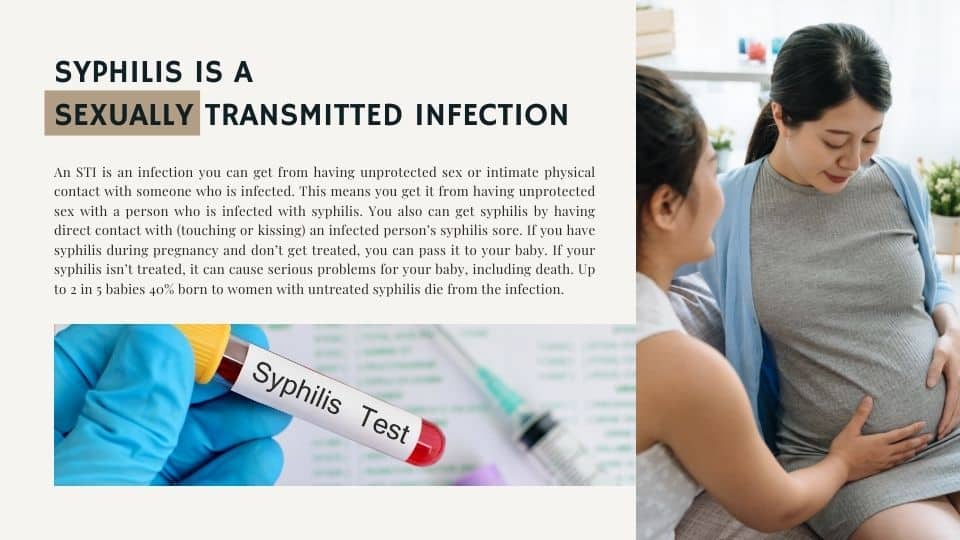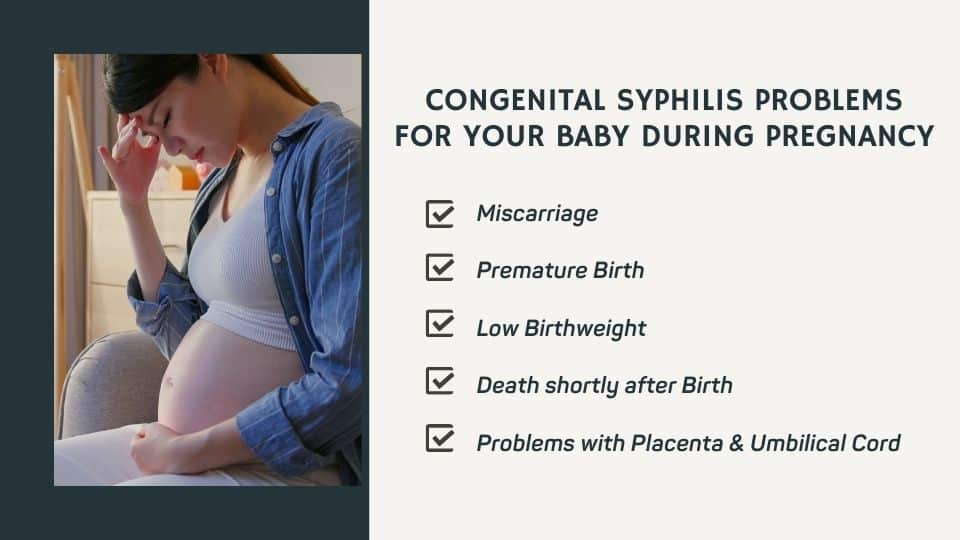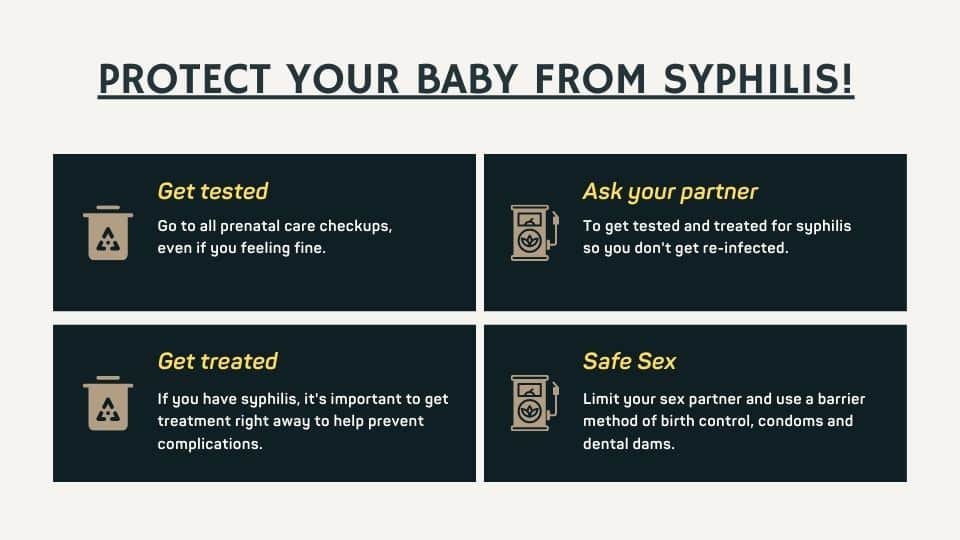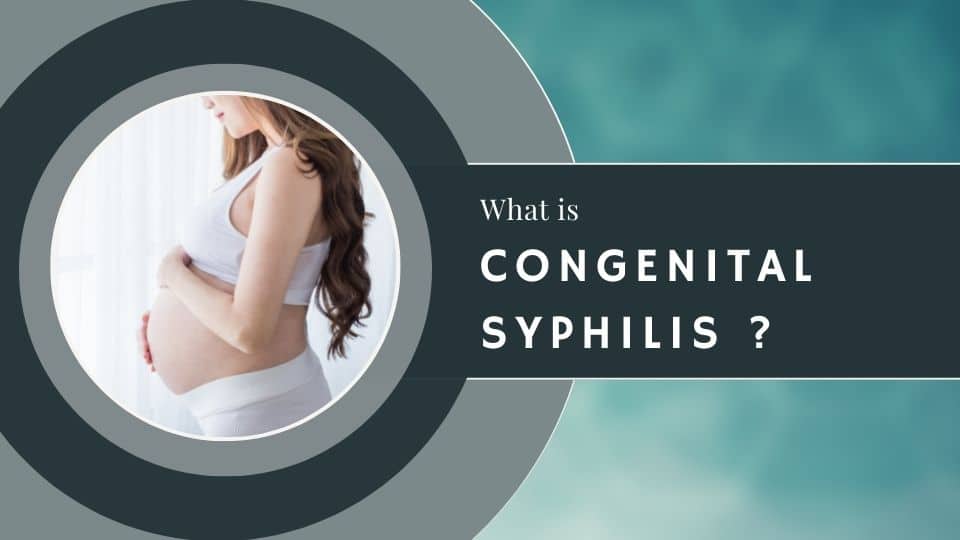What is congenital syphilis?
Congenital Syphilis is when your baby is born infected with syphilis. The only way your baby can get congenital syphilis is if you have syphilis and pass it to your baby. Most of the time, syphilis is passed from mom to baby during pregnancy, but it can happen during vaginal birth if your baby has direct contact with a syphilis sore. Vaginal birth is when contractions in your uterus (womb) help push your baby out through the vagina.
Syphilis is a sexually transmitted infection (also called STI, sexually transmitted disease or STD). An STI is an infection you can get from having unprotected sex or intimate physical contact with someone who is infected. This means you get it from having unprotected sex with a person who is infected with syphilis. You also can get syphilis by having direct contact with (touching or kissing) an infected person’s syphilis sore. If you have syphilis during pregnancy and don’t get treated, you can pass it to your baby. If your syphilis isn’t treated, it can cause serious problems for your baby, including death. Up to 2 in 5 babies (40 percent) born to women with untreated syphilis die from the infection


What Causes congenital syphilis?
Congenital syphilis is caused by the bacteria Treponema pallidum, which is passed from mother to child during fetal development or at birth. Up to half of all babies infected with syphilis while they are in the womb die shortly before or after birth.
How can congenital syphilis affect your baby during and after pregnancy?
Congenital syphilis can cause complications for your baby during pregnancy and after birth. Your baby may seem healthy at birth, but syphilis may cause health complications later in life if he doesn’t get treated right away. Complications depend on how long you were infected with syphilis during pregnancy and if and when you got treatment.
Congenital syphilis can cause problems for your baby during pregnancy, including
- Miscarriage. Miscarriage is when a baby dies in the womb before 20 weeks of pregnancy.
- Premature birth. This is birth that happens too soon, before 37 weeks of pregnancy.
- Fetal growth restriction (also called growth-restricted, small for gestational age or small for date) and low birthweight. Fetal growth restriction is when a baby doesn’t gain the weight she should before birth. Low birthweight is when a baby is born weighing less than 5 pounds, 8 ounces.
- Problems with the placenta and the umbilical cord. The placenta grows in your uterus (womb) and supplies your baby with food and oxygen through the umbilical cord. Congenital syphilis may cause the placenta to grow large and the umbilical cord to be swollen, which can cause problems with how they work to support your baby in the womb.
- Stillbirth. This is when a baby dies in the womb after 20 weeks of pregnancy.
- Death shortly after birth.
- Babies born to women with untreated syphilis may be stillborn, or die from the infection as a newborn.
Congenital syphilis can cause problems for your baby at birth, too, including
- Neonatal death. This is when a baby dies in the first 28 days of life.
- Fever
- Problems with the spleen and liver, including jaundice and hepatosplenomegaly. Jaundice is when your baby’s skin and the white parts of her eyes look yellow. It’s caused by the build-up of a substance in the blood called bilirubin. If your baby has congenital syphilis, her liver may not be developed enough to remove bilirubin on its own. Hepatosplenomegaly is when her liver and spleen are swollen.
- Anemia. Anemia is when your baby doesn’t have enough healthy red blood cells to carry oxygen to the rest of her body.
- A rash on her mouth, genitals (also called sex organs) or anus, or on the bottoms of her feet and on her hands and face.
- Runny nose
- Meningitis. This is an infection that causes swelling in the brain and spinal cord.
- Deformed bones.
- Brain and nerve problems, like blindness or deafness.
- Not able to move a painful arm or leg
- Abnormal notched and peg-shaped teeth, called Hutchinson teeth
- Bone pain
- Clouding of the cornea (the covering of the eyeball)
- Deformity of the nose with flattened nasal bridge (saddle nose)
- Gray, mucus-like patches around the anus and vagina
- Joint swelling
- Saber shins (bone problem of the lower leg)
- Scarring of the skin around the mouth, genitals, and anus
If not treated right away, congenital syphilis can cause problems for your baby later in life, including
- Problems with his bones and joints, including pain, swelling and conditions like saber shin, saddle nose and Hutchinson teeth. Saber shin is when your baby’s shin (front of the lower leg) is curved out. Saddle nose is when your baby has a flat nose. Hutchinson teeth are teeth that are peg-shaped and far apart from each other.
- Vision problems
- Hearing problems
- Problems with the nervous system, including having paralyzed arms or legs and seizures. The nervous system includes your baby’s brain, spinal cord and nerves. It helps your baby move, think and feel. Paralyzed arms and legs means your baby can’t move them. Seizures are when the whole body or parts of the body move without control.
- Developmental delays. Developmental delays are when your child doesn’t reach developmental milestones when expected. A developmental milestone is a skill or activity that most children can do at a certain age. Milestones include sitting, walking, talking, having social skills and having thinking skills.

How is congenital syphilis diagnosed in your baby?
At your prenatal care visits, your health care provider does blood tests to check you for STIs, including syphilis. If you have syphilis, tell your baby’s provider about any treatment you had during pregnancy. A routine blood test for syphilis is done during pregnancy. The mother may receive the following blood tests:
- Fluorescent treponemal antibody absorbed test (FTA-ABS)
- Rapid plasma reagin (RPR)
- Venereal disease research laboratory test (VDRL)
An infant or child may have the following tests:

- Bone x-ray
- Dark-field examination to detect syphilis bacteria under a microscope
- Blood tests
- Physical exam
- Eye exam to check your baby’s vision
- X-ray. This is a medical test that uses radiation to make a picture of your body on film.
- Ultrasound. This test uses sound waves and a computer screen to show a picture of your baby inside the womb.
- Spinal tap (also called lumbar puncture). For this test, your baby’s provider pushes a small needle into your baby’s lower back to remove a small amount of cerebrospinal fluid. Cerebrospinal fluid is found around the brain and spinal cord. You baby’s provider sends the fluid for testing at a lab.
How is congenital syphilis treated?
If your baby has congenital syphilis, her provider treats her with an antibiotic called penicillin. An antibiotic is a medicine that kills certain infections. Your baby may get penicillin as a shot or through an intravenous line (also called IV). An IV is when your baby gets medicine through a needle in her vein in her hand, foot, arm, leg or scalp.
The amount of treatment your baby gets depends on her infection and condition. For some babies, congenital syphilis can be completely cured. For others, they may need treatment for health conditions caused by the infection. If your baby has congenital syphilis, it’s important that she gets treatment right away to help prevent complications. Take your baby to all her medical checkups to make sure her treatment is working.
How is congenital syphilis prevention?
Congenital syphilis is completely preventable. You can protect your baby from the infection by protecting yourself from the infection. The only way for your baby to get infected is by getting it from you during pregnancy and birth.
Here’s how to protect yourself and your baby from syphilis:
- Don’t have sex. This is the best way to protect yourself from STIs, including syphilis.
- If you do have sex, have safe sex. Have sex with only one person who doesn’t have other sex partners. If you’re not sure if your partner has an STI, use a barrier method of birth control. Barrier methods include male and female condoms and dental dams. A dental dam is a square piece of rubber that can help protect you from STIs during oral sex.
- Go to all your prenatal care checkups, even if you’re feeling fine. Many cases of syphilis happen in women who don’t get regular prenatal care. At your prenatal care checkups, your provider asks you questions to see if you may be at risk for syphilis and other infections that can affect your pregnancy. If you’re at risk for syphilis, your provider gives you a blood test to see if you have the infection.

- Get tested and treated. If you think you may have syphilis, tell your provider right away. He can test you for syphilis and begin treatment if you’re infected. The sooner you’re treated, the less likely you and your baby are to have complications from your infection.
- Ask your partner to get tested and treated for syphilis. If you get treated for syphilis, you’re no longer infected. But if your partner is infected, you can get infected again. This is called reinfection. Ask your partner to get tested and treated to protect you from infection and reinfection.
References
- Congenital Syphilis – CDC Fact Sheet https://www.cdc.gov/std/syphilis/stdfact-congenital-syphilis.htm
- Congenital syphilis https://www.mountsinai.org/health-library/diseases-conditions/congenital-syphilis
- CONGENITAL SYPHILIS https://www.marchofdimes.org/complications/congenital-syphilis.aspx

